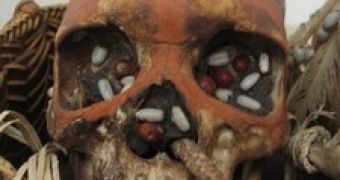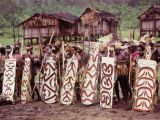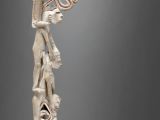Head hunting was a common practice in many Indigenous societies, from the Jivaro of the Amazon basin to the Dayaks of Borneo and many other Malay-Polynesian groups in Indonesia and Pacific islands. One of the most feared head hunter populations inhabits the island of New Guinea.
The Asmat tribe is famous for its bloody inter-tribal wars, decapitations and ritualistic cannibalism. This people live in Irian Jaya, in southwestern New Guinea, between the mountain chain of Jaywijaya and the Arafura Sea, on an area of 27,000 square km (11,000 square mi).
Today, about 70,000 Asmat inhabit the area. Despite their horrific preceding fame, these people developed a refined art and are skilled wood carvers, drawing the inspiration from their religion. The most famous are the Asmat totemic poles, made of human figures and bodies which lean and continue each other, in an endless "chain of life".
Asmat live in a land of mud and mangroves; the presence of so many water flows and canals forced the Asmat people to build palafitos, houses raised on posts and connected to each other via bridges and gangways. In fact, the configuration of the water covered surface in the area constantly changes.
Beyond the mangrove forest, forming a barrier against the sea waters, the muddy beach can stretch for kilometers. In this environment, the Asmat world configured the presence of spirits, invisible for the Whites, but visible for them. The Asmat give these spirits a carved shape. The spirits can be friendly or evil, intervening during the tribal conflicts.
The spears, the shields, the drums are art items meant to be turned into the dwelling of a spirit that will help the warrior during confrontations. The hunting horns are adorned with the stylized motifs of insects, birds and other animals, considered protectors. The commonest represented animals are the parrot and the possum. The praying mantis is carved on the prows of the war canoes (used for fishing in peace time). Why this carnivorous insect? Remember that during the copulation, the female of the praying mantis starts eating her male, head first!
The Asmat consider that at the puberty, the spirit of the boy leaves his body and inside his body the spirit of his warrior ancestor will install for insufflating virile energy, required for defending the values of its kin. As the vital force of the trees resides in their fruits, for the Asmat the vital force of the warriors resides in their heads. Thus, another "fruit" that must be... cut.
Following a bloody war expedition against an enemy tribe, the warriors return to their village that splendidly adorned by the women. The skull of the killed warrior is submitted to a veritable beauty session, made by the elders. The braincase is painted in red-ocher and white, the colors of life and death. The eye sockets are filled with clam shells, then the whole is covered with fresh seeds. This way decorated, the head does not resemble a human head, but the skull of the immortal Desoipitsj, a type of Adam of the Asmat.
During the initiation rite of the boys, culminating with a dramatic probe, this skull is crucial. In the ceremonial hut, under the strict surveillance of the "ancestors' posts", called Bis, which serve for keeping a certain genealogical order in the domestic space, the young boy will spend the night watching, while keeping the head of his ancestor between his spread legs. The new power enters him, like a fluid which the boy must absorb.
The family of the warrior fallen during the head hunting, besides the funerary rites, must dedicate him a carving, too. The great carved post is a cluster of anthropomorphous figures, crossed by a vital flow from one edge to the other. From the chest of the ancestor emerge a vine, like a flag, culminating with a smaller human face, like that of a newborn. The existential chain passes from the first man of the tribe through all his descendants, making an unbreakable tissue. Life is the same, transmitted from generation to generation.

 14 DAY TRIAL //
14 DAY TRIAL // 

